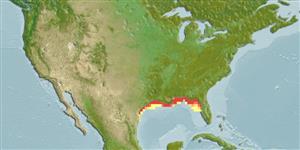>
Clupeiformes (Herrings) >
Alosidae (Shads and Sardines)
Etymology: Alosa: Latin, alausa = a fish cited by Ausonius and Latin, halec = pickle, dealing with the Greek word hals = salt; it is also the old Saxon name for shad = "alli" ; 1591 (Ref. 45335); chrysochloris: From the words chryso, meaning gold and chloris, meaning green (Ref. 10294).
More on author: Rafinesque.
Environment: milieu / climate zone / depth range / distribution range
Sinh thái học
Biển; Nước ngọt; Thuộc về nước lợ; di cư biển sông (để đẻ trứng) (Ref. 51243). Subtropical; 45°N - 23°N, 100°W - 82°W (Ref. 188)
Western Central Atlantic: Gulf of Mexico (from Corpus Christi in Texas eastward to Pensacola in Florida; also in rivers, e.g. Mississippi and Ohio Rivers to Minnesota, Wisconsin and Pennsylvania).
Bộ gần gũi / Khối lượng (Trọng lượng) / Age
Maturity: Lm ? range ? - ? cm
Max length : 50.0 cm SL con đực/không giới tính; (Ref. 188); common length : 37.5 cm SL con đực/không giới tính; (Ref. 188); Khối lượng cực đại được công bố: 1.7 kg (Ref. 4699); Tuổi cực đại được báo cáo: 4 các năm (Ref. 12193)
Các tia vây lưng cứng (tổng cộng) : 0; Tia cứng vây hậu môn: 0. Belly with a distinct keel of scutes. Lower jaw not rising steeply within mouth; teeth prominent at front of lower jaw. Lower gill rakers slender. Back bluish green, abruptly changing to silver on flank; no dark spot at shoulder. Closely resembles A. mediocris of Atlantic coasts, which has no upper and weak lower jaw teeth, a dark shoulder spot and the body deeper than head length (Ref. 188).
Generally present in coastal marine water (Ref. 37039). Enter brackish- and freshwaters, but perhaps not always or not consistently anadromous (Ref. 188), although strongly migratory within rivers (Ref. 10294) , mostly in fast-flowing water where they are renowned for leaping. Feed on small fishes, the juveniles on insects. Spawning times and places not certain. Adults serve as hosts to the larvae (glochidia) of the economically valuable pearly mussel (Fusconaia ebena) of the Mississippi basin (Ref. 188).
Life cycle and mating behavior
Chín muồi sinh dục | Sự tái sinh sản | Đẻ trứng | Các trứng | Sự sinh sản | Ấu trùng
Whitehead, P.J.P., 1985. FAO Species Catalogue. Vol. 7. Clupeoid fishes of the world (suborder Clupeoidei). An annotated and illustrated catalogue of the herrings, sardines, pilchards, sprats, shads, anchovies and wolf-herrings. FAO Fish. Synop. 125(7/1):1-303. Rome: FAO. (Ref. 188)
IUCN Red List Status (Ref. 130435: Version 2024-1)
Threat to humans
Harmless
Human uses
Các nghề cá: buôn bán nhỏ; cá để chơi: đúng
Các công cụ
Special reports
Download XML
Các nguồn internet
Estimates based on models
Preferred temperature (Ref.
123201): 23.1 - 24.6, mean 23.9 °C (based on 126 cells).
Phylogenetic diversity index (Ref.
82804): PD
50 = 0.5000 [Uniqueness, from 0.5 = low to 2.0 = high].
Bayesian length-weight: a=0.00589 (0.00344 - 0.01007), b=3.03 (2.89 - 3.17), in cm total length, based on LWR estimates for this species & Genus-body shape (Ref.
93245).
Mức dinh dưỡng (Ref.
69278): 3.9 ±0.63 se; based on food items.
Thích nghi nhanh (Ref.
120179): Trung bình, thời gian nhân đôi của chủng quần tối thiểu là 1.4 - 4.4 năm (tmax=4).
Fishing Vulnerability (Ref.
59153): Moderate vulnerability (44 of 100).
